Keyword
Energieträger
23 record(s)
Provided by
Type of resources
Available actions
Topics
Keywords
Contact for the resource
Update frequencies
Service types
-
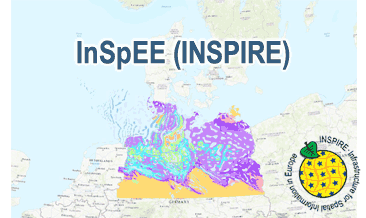
The WMS InSpEE (INSPIRE) provides information about the areal distribution of salt structures (salt domes and salt pillows) in Northern Germany. Contours of the salt structures can be displayed at horizontal cross-sections at four different depths up to a maximum depth of 2000 m below NN. The geodata have resulted from a BMWi-funded research project “InSpEE” running from the year 2012 to 2015. The acronym stands for "Information system salt structures: planning basis, selection criteria and estimation of the potential for the construction of salt caverns for the storage of renewable energies (hydrogen and compressed air)”. Taking into account the fact that this work was undertaken at a scale for providing an overview and not for investigation of single structures, the scale of display is limited to a minimum of 1:300.000. Additionally four horizontal cross-section maps display the stratigraphical situation at a given depth. In concurrence of maps at different depths areal bedding conditions can be determined, e.g. to generally assess and interpret the spread of different stratigraphic units. Clearly visible are extent and shape of the salt structures within their regional context at the different depths, with extent and boundary of the salt structures having been the main focus of the project. Four horizontal cross-section maps covering the whole onshore area of Northern Germany have been developed at a scale of 1:500.000. The maps cover the depths of -500, -1000, -1500, -2000 m below NN. The four depths are based on typical depth requirements of existing salt caverns in Northern Germany, mainly related to hydrocarbon storage. The shapes of the structures show rudimentary information of their geometry and their change with depths. In addition they form the starting point for rock mechanical calculations necessary for the planning and construction of salt caverns for storage as well as for assessing storage potentials. The maps can be used as a pre-selection tool for subsurface uses. It can also be used to assess coverage and extension of salt structures. Offshore areas were not treated within the project. All horizontal cross-section maps were adjusted with the respective state geological survey organisations. According to the Data Specification on Geology (D2.8.II.4_v3.0) the WMS InSpEE (INSPIRE) provides INSPIRE-compliant data. The WMS InSpEE (INSPIRE) contains two group layers: The first group layer “INSPIRE: Salt structures in Northern Germany“ comprises the layers GE.Geologic.Unit.Salt structure types, GE.GeologicUnit.Salt pillow remnants, GE.GeologicUnit.Structure-building salinar and GE.GeologicUnit.Structural outlines. The layer GE.GeologicUnit.Structural outlines contains according to the four depths four sublayers, e.g. GE.GeologiUnit.Structural outlines 500 m below NN. The second group layer „INSPIRE: Horizontal cross-section maps of Northern Germany“ comprises according to the four depths four layers, e.g. Horizontal cross-section map – 500 m below NN. This layer, in turns, contains two sublayers: GE.GeologicFault.Relevant fault traces and GE.GeologicUnit.Stratigraphic Units. Via the getFeatureInfo request the user obtains additional information on the different geometries. In case of the GE.Geologic.Unit.Salt structure types the user gets access to a data sheet with additional information and further reading in German for the respective salt structure via the getFeatureInfo request.
-

InSpEE (INSPIRE) provides information about the areal distribution of salt structures (salt domes and salt pillows) in Northern Germany. Contours of the salt structures can be displayed at horizontal cross-sections at four different depths up to a maximum depth of 2000 m below NN. The geodata have resulted from a BMWi-funded research project “InSpEE” running from the year 2012 to 2015. The acronym stands for "Information system salt structures: planning basis, selection criteria and estimation of the potential for the construction of salt caverns for the storage of renewable energies (hydrogen and compressed air)”. Additionally four horizontal cross-section maps display the stratigraphical situation at a given depth. In concurrence of maps at different depths areal bedding conditions can be determined, e.g. to generally assess and interpret the spread of different stratigraphic units. Clearly visible are extent and shape of the salt structures within their regional context at the different depths, with extent and boundary of the salt structures having been the main focus of the project. Four horizontal cross-section maps covering the whole onshore area of Northern Germany have been developed at a scale of 1:500.000. The maps cover the depths of -500, -1000, -1500, -2000 m below NN. The four depths are based on typical depth requirements of existing salt caverns in Northern Germany, mainly related to hydrocarbon storage. The shapes of the structures show rudimentary information of their geometry and their change with depths. In addition they form the starting point for rock mechanical calculations necessary for the planning and construction of salt caverns for storage as well as for assessing storage potentials. The maps can be used as a pre-selection tool for subsurface uses. It can also be used to assess coverage and extension of salt structures. Offshore areas were not treated within the project. All horizontal cross-section maps were adjusted with the respective state geological survey organisations. According to the Data Specification on Geology (D2.8.II.4_v3.0) the content of InSpEE (INSPIRE) is stored in 15 INSPIRE-compliant GML files: InSpEE_GeologicUnit_Salt_structure_types.gml contains the salt structure types (salt domes and salt pillows), InSpEE_GeologicUnit_Salt_pillow_remnants.gml comprises the salt pillow remnants, InSpEE_GeologicUnit_Structure_building_salinar.gml represents the structural salinar(s), the four files InSpEE_Structural_outlines_500.gml, InSpEE_Structural_outlines_1000.gml, InSpEE_Structural_outlines_1500.gml and InSpEE_Structural_outlines_2000.gml represent the structural outlines in the corresponding horizontal cross-sections, the four files InSpEE_GeologicUnit_Cross_Section_500, InSpEE_GeologicUnit_Cross_Section_1000, InSpEE_GeologicUnit_Cross_Section_1500 and InSpEE_GeologicUnit_Cross_Section_2000 display the stratigraphical situation in the corresponding horizontal cross-sections and the four files InSpEE_GeologicStructure_500.gml, InSpEE_GeologicStructure_1000.gml, InSpEE_GeologicStructure_1500.gml and InSpEE_GeologicStructure_2000.gml comprise the relevant fault traces in the corresponding horizontal cross-sections. The GML files together with a Readme.txt file are provided in ZIP format (InSpEE-INSPIRE.zip). The Readme.text file (German/English) contains detailed information on the GML files content. Data transformation was proceeded by using the INSPIRE Solution Pack for FME according to the INSPIRE requirements.
-
Informationen zu zahlreichen Projekten der Energiewende in Hamburg Weitere Informationen: www.hamburg.de/energiewende
-
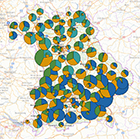
Stromerzeugung aus erneuerbaren Energien unterteilt nach Energieträger als Kreisdiagramm je Landkreis in Bayern.
-
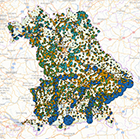
Stromerzeugung aus erneuerbaren Energien unterteilt nach Energieträger als Kreisdiagramm je Gemeinde in Bayern.
-
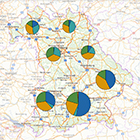
Stromerzeugung aus erneuerbaren Energien unterteilt nach Energieträger als Kreisdiagramm je Regierungsbezirk in Bayern.
-
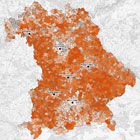
Statistiken auf Gemeinde-, Landkreis- und Regierungsbezirksebene in Bayern: Stromerzeugung aus erneuerbaren Energien nach Energieträger; Anteil von Strom aus erneuerbaren Energien am Stromverbrauch
-

Horizontal cross-section maps display the geological situation at a given depth. In concurrence of maps at different depths areal bedding conditions can be determined, e.g. to generally assess and interpret the spread of different stratigraphic units. Clearly visible are extent and shape of the salt structures within their regional context at the different depths, with extent and boundary of the salt structures having been the main focus of the project. Four horizontal cross-section maps covering the whole onshore area of Northern Germany have been developed at a scale of 1:500.000. The maps cover the depths of -500, -1000, -1500, -2000 m below NN. The four depths were selected by the project partners and are based on typical depth requirements of existing salt caverns in Northern Germany, mainly related to hydrocarbon storage. The shapes of the structures show rudimentary information of their geometry and their change with depths. In addition they form the starting point for rock mechanical calculations necessary for the planning and construction of salt caverns for storage as well as for assessing storage potentials. The maps can be used as a pre-selection tool for subsurface uses. It can also be used to assess coverage and extension of salt structures. As, at the time of preparation of the maps, energy storage and cavern operation in offshore areas could not be assumed as a priority, such areas were not treated within the project. All horizontal cross-section maps were adjusted with the respective state geological survey organisations.
-

Eine interaktive Karte der Statistischen Ämter des Bundes und der Länder zeigt den Energieverbrauch der Industrie auf Kreisebene. Kreise mit den energieintensivsten Industriebetrieben 2019 waren Ludwigshafen am Rhein (206 Petajoule), der Rhein-Erft-Kreis (147 Petajoule), Saarlouis (102 Petajoule) und Bremen (87 Petajoule). An vielen großen Industriestandorten spielte Erdgas, das bundesweit der wichtigste Energieträger war, eine große Rolle. So hatte der energieintensivste Kreis Ludwigshafen am Rhein einen Erdgasanteil von über 50 %, den höchsten Anteil an Erdgas hatte Wittenberg in Sachsen-Anhalt mit über 90 %. An anderen Orten fallen die erneuerbaren Energien stärker ins Gewicht: Den höchsten Verbrauch von erneuerbaren Energien hatte die Industrie im Kreis Stendal mit gut 14 Petajoule. Hier waren die erneuerbaren Energien auch der wichtigste Energieträger. Im Alb-Donau-Kreis verbrauchte die Industrie gut 5 Petajoule erneuerbare Energien und im Kreis Warendorf 2 Petajoule. Kohle als Energieträger kam vor allem im Rhein-Erft-Kreis, im Burgenlandkreis und im Kreis Soest zum Einsatz.
-

Horizontal cross-section maps display the geological situation at a given depth. In concurrence of maps at different depths areal bedding conditions can be determined, e.g. to generally assess and interpret the spread of different stratigraphic units. Clearly visible are extent and shape of the salt structures within their regional context at the different depths, with extent and boundary of the salt structures having been the main focus of the project. Four horizontal cross-section maps covering the whole onshore area of Northern Germany have been developed at a scale of 1:500.000. The maps cover the depths of -500, -1000, -1500, -2000 m below NN. The four depths were selected by the project partners and are based on typical depth requirements of existing salt caverns in Northern Germany, mainly related to hydrocarbon storage. The shapes of the structures show rudimentary information of their geometry and their change with depths. In addition they form the starting point for rock mechanical calculations necessary for the planning and construction of salt caverns for storage as well as for assessing storage potentials. The maps can be used as a pre-selection tool for subsurface uses. It can also be used to assess coverage and extension of salt structures. As, at the time of preparation of the maps, energy storage and cavern operation in offshore areas could not be assumed as a priority, such areas were not treated within the project. All horizontal cross-section maps were adjusted with the respective state geological survey organisations.
 www.geodatenkatalog.de (S3F)
www.geodatenkatalog.de (S3F)